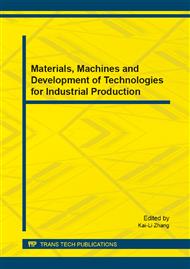[1]
T. Roland and G.J. Walter: Production of volatile compounds in the ripening banana. Journal of Agriculture and Food Chemistry. Vol. 20(1972): 189–192.
Google Scholar
[2]
H. Guth and W. Grosch: Identification of potent odourants in static headspace samples of green and black tea powders on the basis of aroma extract dilution analysis (AEDA), Flavour and Fragrance Journal. Vol. 8(1993): 173-178.
DOI: 10.1002/ffj.2730080402
Google Scholar
[3]
Q. Zhu, Z.P. Shi, C.M. Ren: Changes of aroma of instant green tea during the process by vaccum distillation extract, Journal of Hunan Agricultural University (Natural Sciences), Vol. 27(2001): 218-220.
Google Scholar
[4]
L. Russell and R.C. Keith: Headspace analysis of foods and flavors, New York: Kluwer Academic/Plenum Publishers. (2011).
Google Scholar
[5]
M. Zhu, E. Li and H. He. Determination of volatile chemical constitutes in tea by simultaneous distillation extraction, vacuum hydrodistillation and thermal desorption. Chromatographia. Vol. 68 (2008): 603-610.
DOI: 10.1365/s10337-008-0732-1
Google Scholar
[6]
N. Lu, X.C. Wan and D. Pan: Extraction and analysis of jasmine tea aroma constituents of three different grades. Food science. Vol. 25(2004): 93-96.
Google Scholar
[7]
C.M. Zhou, H.B. Yan, Z.R. Chen, et al. Analysis on aromatic constituents of fragrant green teas, Guangzho Food science and technology. Vol. 20(2004): 101–104.
Google Scholar
[8]
D.Y. Hou, R.H. Hui, T.C. Li, et al.: Study on elavour components of teas: comparison of flavour components by wulong tea and raw tea. Journal of Anshan Normal University. Vol. 5(2003): 53-55.
Google Scholar
[9]
Y.J. Li and Z.P. Shi: Extraction of tea aroma by absorption column method and SDE method. Journal of Hunan Agricultural University (Natural Sciences). Vol. 27(2001): 295-299.
Google Scholar
[10]
S. Milsuya, S. Horoko, S. Hideki S., et al.: Comparison of the odor concentrates by SDE and adsorptive column method form tea infusion. Journal of Agriculture and Food Chemistry, 43(1995): 1616-1620.
DOI: 10.1021/jf00054a037
Google Scholar
[11]
K. Yanagimoto, H. Ochi, K.G. Lee, et al.: Antioxidative activities of volatile extracts from green tea, Oolong tea, and black tea. Journal of Agriculture and Food Chemistry. Vol. 51(2003): 7396-7401.
DOI: 10.1021/jf030127i
Google Scholar
[12]
S.X. Dai, C.J. Xie, D. Chen, et al.: Principal component analysis on aroma constituents of seven high aroma pattern Oolong Teas. Journal of South China Agricultural University. Vol. 20(1999): 113-117.
Google Scholar
[13]
S.X. Dai, C.J. Xie, Q.N. Li., et al.:. Analysis on aromatic constituents of five well-known strains from fenghuang dancong tea cultivar. Journal of tea science. Vol. 18(1998): 39-46.
Google Scholar
[14]
X.Y. Zhang: Research progress of aroma formation mechanism in Oolong tea. Fu jian Tea, Vol. 3(1998): 15-17.
Google Scholar
[15]
Q.E. Wu, L.S. Tang and Z.J. Wang: Technical parameters of mechanical withering for Oolong tea. Journal of Tea Science. Vol. 15(1994): 39-42.
Google Scholar
[16]
R.W. Wang, L.X. Zhang, W.L. Yang, et al.: Study on the aroma changes during rotating process of Oolong tea. Journal of Hunan Agricultural University. 3 (1999): 194-199.
Google Scholar


